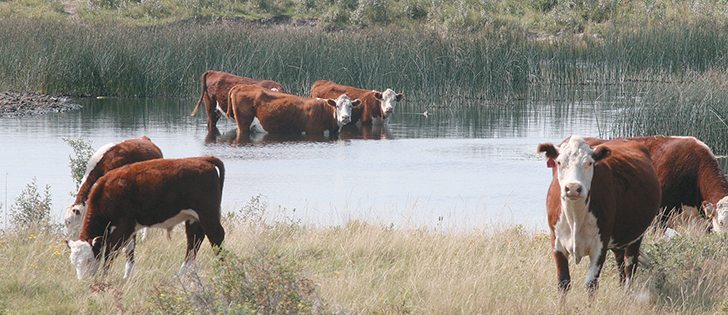Farmers with dugouts need to be mindful of the potential problem with blue green algae.
Melissa Orr-Langner, an agricultural water specialist with Alberta Agriculture, said cyanobacteria “can behave very similarly to algae, growing and multiplying very quickly in the summer months.”
She said it can be difficult to identify, and algae blooms are unpredictable.
“We encourage people to contact your local agricultural water specialist if you suspect you have blue green algae in your dugout, even if you are unsure,” said Orr-Langner.
“Quite often, blue green algae can look like grass clippings in the water or it can be so thick the appearance is like pea soup. You may also notice the algae has a blue green tinge or scum, although not all cyanobacteria will have this feature. Blue green algae is difficult to scoop up. It generally disperses in the water when disturbed.”
Read Also

Manitoba extends Crown land rent freeze
Manitoba government links the continued rental rate freeze on grazing and forage leases to economic and environmental challenges facing the industry
Cyanobacteria is common in surface water bodies on the Prairies. It can produce toxins that may damage to the nervous system or liver in livestock, pets and humans.
“Cases of animal deaths as a result of drinking water containing cyanobacteria have been reported across the prairie provinces,” said Orr-Langner.
“In humans, skin exposure to toxins produced by the bacteria can result in rashes, eye and skin irritation, sore throat, swollen lips and hay fever-like allergic reactions. Ingesting cyanobacteria can cause nausea, cramps, vomiting, diarrhea, fever, headache, muscle or joint pain, and liver damage. Children could be at a greater risk due to accidental ingestion of water while swimming.”
Producers have a variety of options to prevent blue green algae blooms.
“First of all, they should reduce nutrient loading of their dugouts by adopting beneficial management practices, such as off-site watering systems and grassed buffer strips around dugouts,” Orr-Langner said.
“They can also install an aeration system, which helps reduce algae growth by preventing the recycling of nutrients and by enhancing the conditions for zooplankton to consume algae.”
She also recommends using a blue pond dye.
“The dye changes how sunlight passes through the water, interfering with photosynthesis and reducing plant and algae growth.”
Pond dyes are common on fish farms and golf courses and non-toxic to fish and animals. They are user-friendly and available in liquid form or water-soluble packets.
“Pond dye is most effective when added to the dugout in early spring, before algae and aquatic plant growth takes off in the warm summer months,” said Orr-Langner.
It can be bought from many fish, pond and dugout equipment suppliers.
Producers who suspect they have blue green algae in their dugout should provide an alternative source of water to their livestock and contact their local agricultural water specialist for more information on algae identification, dugout treatment and a list of accredited laboratories to test for cyanobacteria.
“Do not consume, bath or swim in the water,” said Orr-Langner.
“Even after treatment or death of the algae, toxins can remain in the water for some weeks. Since blue green algae tend to accumulate on the surface and along the shoreline, use a suspended intake and pumping system for your livestock to reduce the exposure to the algae.”
Dugouts can be treated with a copper-based chemical product regulated by the Pest Management Regulatory Agency.
Producers should contact their local agricultural water specialist for suggested products and follow label directions.
“Over-applying, misuse or repeated treatments of copper products can lead to a buildup of copper in dugout sediments, which can result in a loss of beneficial organisms and disrupt the natural biology of the dugout,” said Orr-Langner.
“When copper is applied during an algae bloom, there may be an immediate release of large quantities of toxins into the water. So, it’s recommended that you wait a minimum of 14 days before using the water for livestock consumption.”















